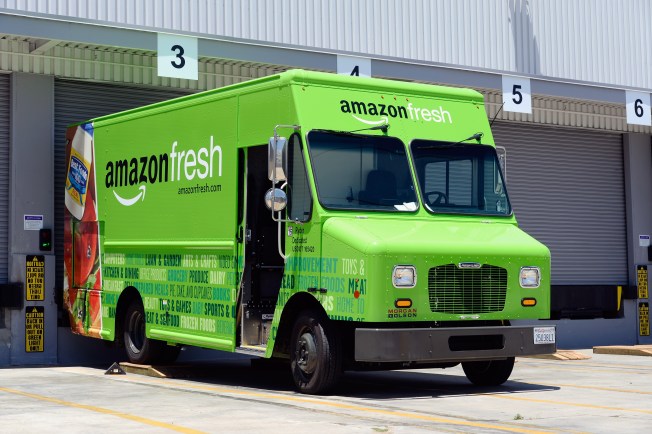Online Grocery Sales Swell to $48 Billion Globally
As omnichannel and ecommerce continue to grow, so too do the offerings of what one can buy over the Internet. Food and fast-moving consumer goods are quickly taking over a decent market share, reaching almost $50 billion worldwide, with no indicator of slowing down anytime soon.
According to a report from Kantar Worldpanel, the fast-moving consumer goods (or FMCG, which are defined as “processed foods, soft drinks, and toiletries that sell quickly at a relatively low cost”) market grew only 1.6 percent globally in the 12 months preceding June 2016. However, online grocery sales have grown by 15 percent, now accounting for 4.4 percent of the FMCG market. The report projects that this online grocery trend will continue to grow, reaching 9 percent of market share by 2025, equating to roughly $150 billion worldwide.

An AmazonFresh truck | Image source: Getty Images (via NBC DFW)
Moreover, the report suggests that online grocery sales in just the United States will jump 157 percent this year as consumers take advantage of new services like Amazon Pantry or — in the case of fresh meats and produce outside of FMCGs — AmazonFresh. Despite the growing trend of ecommerce and online ordering in the United States, our online grocery sales pale in comparison to South Korea, whose online sales comprise a whopping 16.6 percent of the digital FMCG market — and it’s expected to surge to 25 percent.
As observed by Internet Retailer: “In South Korea, thanks to high Internet speeds and 85 percent smartphone penetration, nearly 100 percent of consumers ages 10 to 40 shop online, many via mobile devices.” By comparison in the United Kingdom, for example, only 13 percent of households use their mobile devices to shop online for groceries. In the United States’ case, the Kantar report suggests that online food shopping is so low due to ingrained consumer habits of buying one item at a time rather than en masse in one basket. As American online shopping habits are namely set by Amazon, the average American shopper is trained to buy items individually, though again, this is primed to change.
See what I did there?
Building Momentum
Though it might seem strange ordering groceries online, there are plenty of other countries who are embracing the trend faster than American consumers — something the Kantar report warns might be detrimental to competitors who show up late to the party:
“Kantar Worldpanel said its research shows that ‘the FMCG ecommerce market is unkind to latecomers,’ and the report urges brands to ‘get on the shopping list’ before consumer habits become entrenched. Kantar Worldpanel data shows that 55 percent of online grocery shoppers repeatedly by the same brands from the same merchants from one purchase to the next.”
Luckily for us, we still are within the Top 10 countries capitalizing on the digital grocery bandwagon. In case you were wondering who the other nine were taking the lead in the online grocery sales market by share…
- South Korea (16.6%)
- Japan (7.2%)
- United Kingdom (6.9%)
- France (5.3%)
- Taiwan (5.2%)
- China (4.2%)
- Czech Republic (2.1%)
- Spain (1.7%)
- Netherlands (1.7%)
- United States (1.4%)
Interestingly enough, the Kantar report notes that “online grocery shopping is steadily growing on a global basis but unevenly by region, with variance showing little correlation to levels of Internet connectivity.” While Internet access has an obvious role to play in online shopping, these trends are influenced more by consumer buying habits in each country and the prevalence of digital grocery services.
Either way, as more people take to the Internet for their shopping needs, more businesses will follow suit in order to adjust to the market demand. It turns out that shoppers actually spend more shopping for groceries online than they do to a brick-and-mortar store; U.K. shoppers spend an average of $59 on online purchases compared to $15 in-store, just under a whopping fourfold increase!
With 2025 still a ways off and with technology like drone delivery, pop-up retailing, and other crazy logistics models that blur the lines between the digital and physical realms, it’ll be interesting to see whether or not the FMCG and online grocery market will meet its target of 9 percent or surpass it. One thing is certain, however: people do love ordering things online.
I still can’t get over South Korea’s level of digital retailing at virtually 100 percent.

